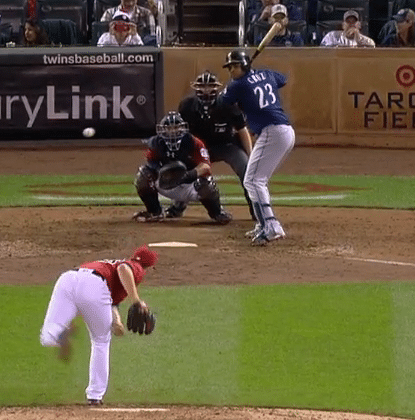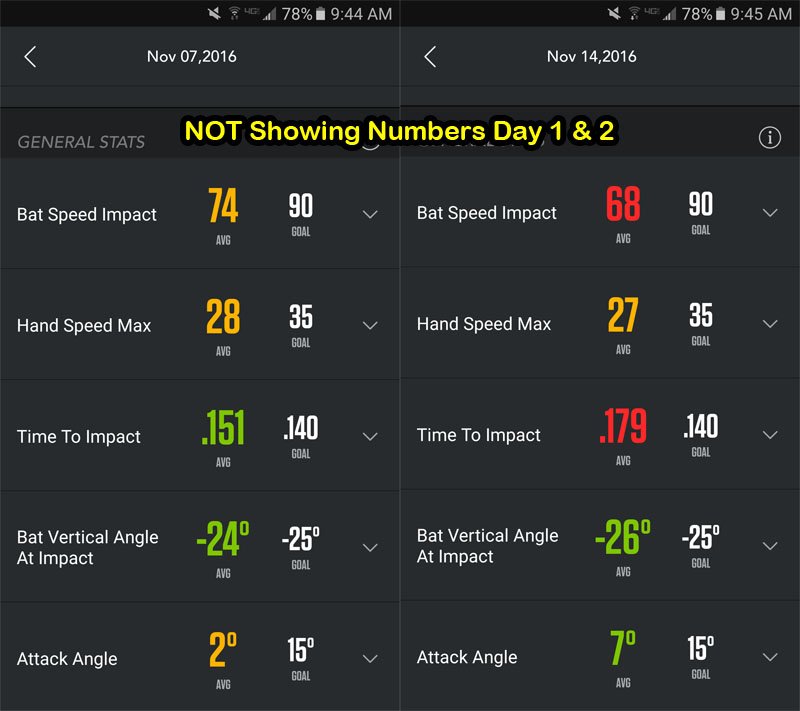Learn how to teach kids to increase youth baseball hitting power. Also discover how to hit Fast-pitch or Slow-pitch softball better, farther, and in a certain direction. Home-run batting tips revealed in this swing experiment post…
Want To ADD Between 25 to 40-Feet Of Batted Ball Distance?

Nelson Cruz ‘showing numbers’ hitting a 2-run monster shot traveling 463-feet with a launch angle of 23.7-degrees off 75-mph CB on 09/23/16. Photo courtesy: MLB.com
(‘Showing Numbers’ Experiment REVISITED)
Question: Is Increased Bat & Ball Exit Speed ALL in the Hips?
Using the Zepp (Labs) Baseball app, I wanted to use the Scientific Method to analyze whether ‘Showing the Numbers’ to the pitcher is more effective than ‘NOT Showing’ them when it comes to measuring Bat and Ball Exit Speeds.
In this swing experiment, I had professional hitter of mine that I’ve been working with for a few months, Preston Scott, do the hitting.
Background Research
I’m revisiting an earlier experiment I did, looking into whether power was ALL in the hips. You can CLICK HERE to read and watch the experiment findings.
Not to beat the springy fascia horse, but you can get more background information on why this swing experiment turned out like it did by reading through the following video blog posts.
- Miguel Cabrera and the timing of torque.
- Josh Donaldson v. Jose Bautista: how spine engine mechanics are amplified by Gravitational Forces, and
- Adrian Gonzalez: how-to naturally spring load the body.
SCIENCE-BASED TRAINING:
Improve your hitting strategy dramatically by applying human movement principles.
Learn not only how and what to train but also the science behind the methods.
Hypothesis
From the research into Anatomy Trains (Thomas Myers), The Spinal Engine
(Dr. Serge Gracovetsky), and from my past swing experiment, I expect to see similar results…maybe even slightly lower numbers favoring ‘Showing Numbers’.
I say slightly lower numbers because in the first experiment I didn’t counter-balance the swings. In other words, I took 100 consecutive swings ‘NOT Showing Numbers’ first, then took another 100 consecutive swings ‘Showing Numbers’. This may have caused a “getting tired” or “not warmed up yet” effect, therefore biasing the experiment results.
The big UPDATES to the experiment will be:
- Adding the measure of Ball Exit Speed,
- Counter-balancing the swings, and
- Professional Preston Scott taking the swings, not me.
I’m interested to see how this experiment turns out…
ADD Ball Exit Speed Swing Experiment
Equipment Used:
- Zepp Baseball app (to measure Bat Speed, Hand Speed, Time to Impact, & Attack Angle),
- Bushnell Radar Gun
(to measure Ball Exit Speed, or BES),
- Backspin batting tee,
- Two yellow dimple baseballs (feedback markers),
- Android GS6 video camera and Tripod, and
- 34 inch wood bat.
Setup:

Preston Scott: ‘NOT Showing’ versus ‘Showing Numbers’
- Yellow dimple ball feedback markers to keep starting footwork the same = bat length
- Tee was set one baseball’s length behind the front feedback marker, and tee height was about mid-thigh
- Forward momentum was eliminated in this experiment, and Preston hit from a 1-2 second pause at landing
- We stayed as consistent as we could with keeping the ball height and depth the same for most swings.
- I used two yellow dimple ball markers to make my stance setup consistent…one was placed inside my back foot, close to the plate. The other was placed one bat’s length ahead of the back marker.
- The two tests in the swing experiment were counter-balanced. Which consisted of eight blocks of 25-swings done in the following order ABBA BAAB. ‘NOT Showing Numbers’ was letter ‘A’, and ‘Showing Numbers’ was letter ‘B’. 200 total swings were completed in the experiment, 100 per test. Counter-balancing helps remove the “getting tired” and “warm up” factors.
- On ‘NOT Showing Numbers’ swings, Preston kept his shoulders in line with the blue band on the ground in front of him (towards the pitcher). And on ‘Showing Numbers’ swings, he kept his shoulders in line with the red band that was set at about a 30-degree angle from the blue band.
- Preston Scott was sipping a protein shake throughout the length of the experiment to aid in recovery.
- On both experiment days, Preston had finished “leg day” at the gym, so our warm-up was brief, followed by about 15-20 swings off the tee.
- We had to break the 200 total swings (4 sets of 25 swing chunks each day) into two days, with the second day coming 1 week later because of time constraints.
- It’s important to note, Preston and I were working on improving his mechanics slightly different both days (having nothing to do with ‘showing numbers’), but even though Day 1 (November 7, 2016), and a week later, Day 2 (November 14, 2016) swings may look a bit different, the slightly differing mechanics were used for BOTH ‘NOT Showing Numbers’ and ‘Showing Numbers’ tests, so as not to muddy the experiment results.
Data Collected (Zepp Baseball App):
‘NOT Showing Numbers’ Day 1 & 2 side by side comparison…

‘NOT Showing Numbers’ Averages of averages: 71-mph Bat Speed at Impact, 27.5-mph Hand Speed Max, 0.165 Time To Impact, -25* Bat Vertical Angle at Impact, & 4.5* Attack Angle
‘Showing Numbers’ Day 1 & 2 side by side comparison…

‘Showing Numbers’ Averages of Averages: 76-mph Bat Speed at Impact, 28-mph Hand Speed Max, 0.162 Time to Impact, 28* Bat Vertical Angle at Impact, & 6* Attack Angle
Also, CLICK HERE to access the Google Drive spreadsheet with all Ball Exit Speed (BES) readings from the experiment.
Data Analysis & Conclusion
Starting with Zepp data analysis comparing the averages of averages:
- 5-mph INCREASE in Bat Speed at Impact with ‘Showing Numbers’
- 0.5-mph INCREASE in Hand Speed Max with ‘Showing Numbers’
- .003 second DECREASE in Time to Impact with ‘Showing Numbers’
- 3* INCREASE in Bat Vertical Angle at Impact with ‘Showing Numbers’
- 1.5* INCREASE in Attack Angle with ‘Showing Numbers
Now, let’s see how the Ball Exit Speed averages compare between the two mechanics:
- 76.02-mph BES when ‘NOT Showing Numbers’
- 77.32-mph BES when ‘Showing Numbers’
- That’s a 1.3-mph average INCREASE when ‘Showing Numbers’
- Translates between 5.2-feet to 7.8-feet of EXTRA batted ball distance – depending on if you calculate using 1-mph BES = 4-feet of distance OR 1-mph BES = 6-feet of distance.
Notes
- In this experiment, if you look at the ‘NOT Showing Numbers’ swings, they were actually ‘Showing Numbers’. In other words, Preston already shows his number to the pitcher well causing him a challenge to not show them. Therefore on the ‘Showing Numbers’ swings, he showed them more. I think that’s why we didn’t see as much of a difference in Ball Exit Speeds.
- One of the big objections from some is that ‘Showing Numbers’ causes an increase in Time To Impact. These results show it doesn’t – it actually decreases Time To Impact. WHY is this? It has to do with ‘taking slack out of the system’ as it relates to compression/tension forces acting within the body.
- Preston Scott generally does a great job of ‘Showing Numbers’, even before I started working with him, so he felt like he really had to try and keep from pulling the ball too much when ‘NOT Showing Numbers’. And as you can see in the video, he was still ‘Showing Numbers’ somewhat, even when he wasn’t suppose to!


